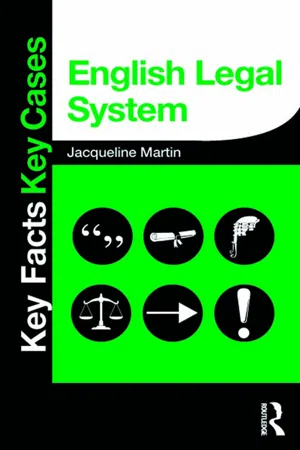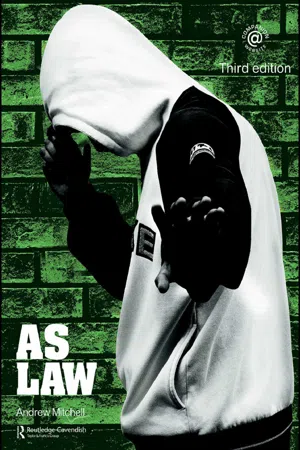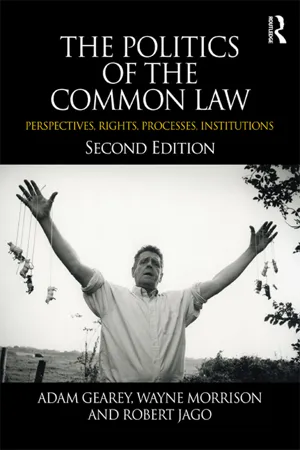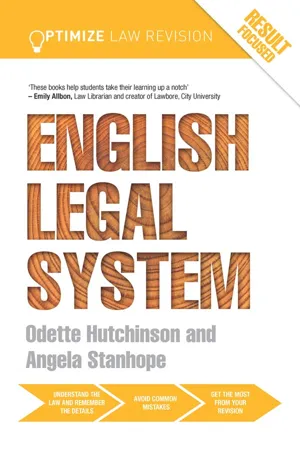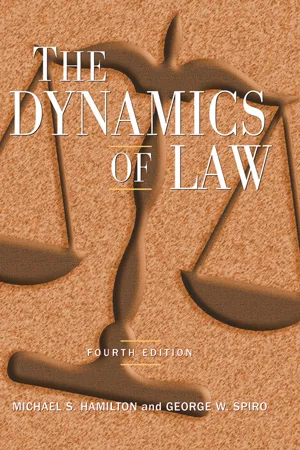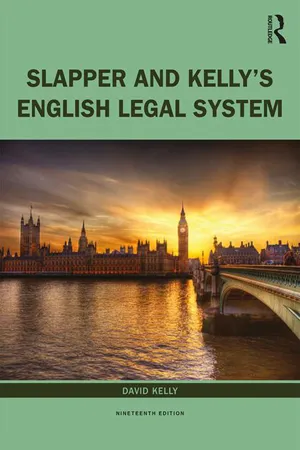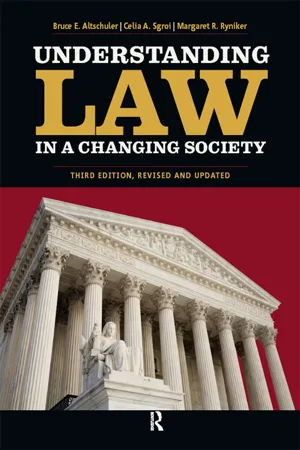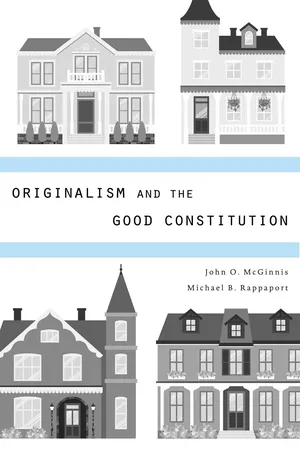Law
Doctrine of Precedent
The Doctrine of Precedent refers to the principle that previous court decisions should guide future rulings in similar cases. It is a fundamental aspect of the common law system, providing consistency, predictability, and fairness in legal decisions. Under this doctrine, lower courts are generally bound to follow the decisions of higher courts within the same jurisdiction.
Written by Perlego with AI-assistance
Related key terms
11 Key excerpts on "Doctrine of Precedent"
- eBook - ePub
- Jacqueline Martin(Author)
- 2014(Publication Date)
- Routledge(Publisher)
2 Judicial precedent2.1 The Doctrine of Precedent2.1.1 Stare decisis1 It is a fundamental principle that like cases should be treated alike.2 The Latin maxim stare decisis (stand by decisions of past cases) is the basis of the Doctrine of Precedent.3 Precedent, as operated in the English legal system, requires that in certain circumstances a decision on a legal point made in an earlier case MUST be followed.4 The doctrine is that:• all courts are bound to follow decisions made by courts above them in the hierarchy; and• appellate courts are normally bound by their own past decisions.5 An extreme example of this was seen following the decision in2.1.2 Original precedentRe Schweppes Ltd’s Agreement (1965), in which one judge in the Court of Appeal dissented. Later on the same day, when the same point of law was involved in a second case (Re Automatic Telephone and Electric Co Ltd’s Agreement (1965)), that judge said he was now bound to follow the earlier decision.1 Where there is no previous decision on a point of law that has to be decided by a court, then the decision made in that case on that point of law is an original precedent.2 Usually, when faced with the situation of having to form an original precedent, the court will reason by analogy. Cases that are nearest to it in principle will be considered, though they are not binding. If there is any parallel, the court may decide that the same type of principle should apply (Hunter and others v Canary Wharf Ltd and London Dockland Development Corporation (1995)).3 - eBook - ePub
- Andrew Mitchell(Author)
- 2008(Publication Date)
- Routledge-Cavendish(Publisher)
4 The doctrine of judicial precedent This topic enables you:- To recognise how an important source of law – judicial law-making based on the Doctrine of Precedent, known as common law – contributes to the English legal system.
- To appreciate that there is a hierarchy of English courts and that this assists the process of precedent through the principle of stare decisis.
- To demonstrate the importance of law reporting in recording precedents.
- To develop knowledge relating to the nature of judicial precedent and how it works in practice.
- To understand the role of judges, building on earlier knowledge of the constitution and the separation of powers.
- To consider the doctrine of parliamentary sovereignty and the extent to which this is undermined by judicial law-making.
Judicial precedent is a system of law-making by judges rather than by Parliament: generally applicable decisions made by judges, referred to as precedents, are used as models for future cases, and these are developed on a case-by-case basis to establish areas of law. This process describes the growth of the common law. Therefore, judicial precedent is an important source of law and a core topic for any student of the English legal system.INTRODUCTION TO JUDICIAL PRECEDENT
The general idea of the precedent system is that the lower courts have to follow the decisions of the higher courts because these have precedent-making powers. This is referred to as the doctrine of stare decisis (which means ‘stand by what has been decided’ - eBook - ePub
The Politics of the Common Law
Perspectives, Rights, Processes, Institutions
- Adam Gearey, Wayne Morrison, Robert Jago(Authors)
- 2013(Publication Date)
- Routledge-Cavendish(Publisher)
6INSTITUTIONALISING JUDICIAL DECISION MAKING: PUBLIC REASON AND THE Doctrine of Precedent
The law of England would be a strange science if indeed it were decided by precedents only. Precedents serve to illustrate principles and to give them a fixed certainty. But the law of England, which is exclusive of positive law, enacted by statute [i.e. Mansfield specifies he is referring to case law developed by the courts], depends upon principles, and these principles run through all the cases according as the particular circumstances of each have been found to fall within the one or the other of them.1If a group of cases involves the same point, the parties expect the same decision. It would be a gross injustice to decide alternate cases on opposite principles. If a case was decided against me yesterday when I was a defendant, I shall look for the same judgment today if I am plaintiff. To decide differently would raise a feeling of resentment and wrong in my breast; it would be an infringement, material and moral, of my rights …. Adherence to precedent must then be the rule rather than the exception if litigants are to have faith in the even-handed administration of justice in the courts.2The paradigm case of injustice is that in which there are two similar individuals in similar circumstances and one of them is treated better or worse than the other. In this case, the cry of injustice rightly goes up against the responsible agent or group; and unless that agent or group can establish that there is some relevant dissimilarity after all between the individuals concerned and their circumstances, he or they will be guilty as charged.3If lawyers hold to their precedents too closely, forgetful of the fundamental principles of truth and justice which they should serve, they may find the whole edifice comes tumbling down about them. Just as the scientist seeks for truth, so the lawyer should seek for justice. Just as the scientist takes his instances and from them builds up his general propositions, so the lawyer should take his precedents and from them build up his general principles. Just as the propositions of the scientist fail to be modified when shown not to fit all instances, or even discarded when shown in error, so the principles of the lawyer should be modified when found to be unsuited to the times or discarded when found to work injustice.4 - eBook - ePub
- Angela Stanhope, Odette Hutchinson(Authors)
- 2014(Publication Date)
- Routledge(Publisher)
stare decisis . This Latin term means ‘to stand by a decision’. Put simply, the doctrine of binding judicial precedent stipulates that the decisions of higher courts bind courts lower in the hierarchy.This is however, a general rule, and law students need to know the limitations of and exceptions to general rules. In particular, if you are answering a question on the doctrine of binding judicial precedent you will need to know:Which courts are bound by their own previous decisions?When and under what circumstances can a court depart from a decision made by a higher court?What mechanisms, if any, exist for avoiding precedents?You will find it helpful to refer to the diagrams of the court structure in Chapter 1 when reading this section.Binding judicial precedentIn practice, precedent operates in the following way. Judges when trying cases will look to see whether the legal issues in the case before them have been dealt with before. In particular, a judge will be looking for decisions by superior courts.If a judge finds a precedent by a superior court, where the material facts of the cases are the same and which raises the same points of law, they will in most cases be bound to follow it.Summary
The doctrine of binding judicial precedent is preferable to allowing judges to decide cases on a case-by-case, or ad hoc basis. By following the decisions of the superior courts, in cases that raise the same legal issues, the law becomes more consistent and predictable. This means that lawyers can provide clients with clear advice as to how best to order their affairs.Law reporting
The only way that a system of binding judicial precedent can work effectively is if the decisions of judges are meticulously recorded and if those decisions are accessible to judges in future cases. As such, we have an extensive law reporting process that operates in the English legal system. This system provides the legal profession with access to judgments, which allows the profession to identify relevant precedents with respect to cases that they are dealing with. - eBook - ePub
- Michael S Hamilton, George W Spiro(Authors)
- 2014(Publication Date)
- Routledge(Publisher)
The fusion of these courts has had some important consequences for litigants. It is now possible, for instance, for a litigant in an action at law to introduce arguments based on equity principles, and vice versa. Over the centuries, equitable principles and remedies have undergone gradual change as judges have had to decide new cases involving novel situations. In addition, legislatures from time to time have broadened the scope and flexibility of equitable remedies and have even created some new remedies modeled on the traditional ones.THE ROLE OF PRECEDENTS: THE DOCTRINE OF STARE DECISIS AND ITS RATIONALE
The power of judges to formulate legal rules in dealing with cases brought before them is limited by the duty, imposed on them by our legal tradition, to seek guidance by looking back at past decisions in similar cases. The principle that judges should build on precedents established by past decisions is known as the doctrine of stare decisis , from the Latin phrase stare decisis et non quieta movere , which means “to adhere to precedents and not unsettle things that are settled.”Observance of stare decisis is more than a deeply rooted tradition, however; it is a logical way for judges to act. Following precedents is often much easier and less time-consuming than working out all over again solutions to problems that have already been faced. It enables judges to take advantage of the accumulated wisdom of successive generations. It conforms to the community’s instinctive belief that like wrongs deserve like remedies and to the desire for equal justice under law .But above all, the practice of following precedents enables citizens (with expert assistance of lawyers) to plan their conduct in the expectation that past decisions will be honored in the future. Certainty, predictability, and continuity are not the only objectives of law, but they are important ones. Many disputes are avoided, and others settled without litigation, simply because people have a good idea about how the courts will respond to certain types of behavior. - eBook - ePub
Precedents, Statutes, and Analysis of Legal Concepts
Interpretation
- Scott Brewer(Author)
- 2013(Publication Date)
- Routledge(Publisher)
The Theory of Judicial Precedents.THE importance of judicial precedents has always been a distinguishing characteristic of English law. The great body of the common or unwritten law is almost entirely the product of decided cases, accumulated in an immense series of reports extending backwards with scarcely a break to the reign of Edward I at the close of the thirteenth century. Orthodox legal theory indeed long professed to regard the common law as customary law, and the reported precedents as merely evidence of the customs and of the law derived therefrom. But this was never much better than an admitted fiction. In practice, if not in theory, the common law of England has been manufactured by the decisions of English judges. Neither Roman law, however, nor any of those modern systems which are founded upon it, allows any such place or authority to precedent. They allow to it no further or other influence than that which is possessed by any other expression of expert legal opinion. A book of reports and a text-book are on the same level. They are both evidences of the law; they are both instruments for the persuasion of judges; but neither of them is anything more1 . English law, on the other hand, draws a sharp distinction between them. A judicial precedent speaks in England with a voice of authority; it is not merely evidence of the law but a source of it; and the courts are bound to follow the law that is so established.It seems clear that we must attribute this feature of English law to the peculiarly powerful and authoritative position which has been at all times occupied by English judges. From the earliest times the judges of the king's courts have been a small and compact body of legal experts. They have worked together in harmony, imposing their own views of law and justice upon the whole realm, and establishing thereby a single homogeneous system of common law. Of this system they were the creators and authoritative interpreters. They did their work with little interference either from local custom or from legislation. The centralization and concentration of the administration of justice in the royal courts gave to the royal judges a power and prestige which would have been unattainable on any other system. The authority of precedents was great in England because of the power, the skill, and the professional reputation of the judges who made them. In England the bench has always given law to the bar; in Rome it was the other way about, for in Rome there was no corporate body of professional judges capable of doing the work that has been done for centuries in England by the royal courts. - eBook - ePub
The Logic of Choice
An Investigation of the Concepts of Rule and Rationality
- Gidon Gottlieb(Author)
- 2019(Publication Date)
- Routledge(Publisher)
Kelsen wrote that, ‘From a dynamic standpoint, the individual norm created by the judicial decision is a stage in a process beginning with the establishment of the first constitution…. Statutes and customary laws are, so to speak, only semi-manufactured products which are finished only through the judicial decision and its execution. The process through which law constantly creates itself anew goes from the general and abstract to the individual and concrete.’ 29 It is the Doctrine of Precedent which holds the key to the mystery of how, in Lord Wright’s well publicized words, ‘… this perpetual process of change can be reconciled with the principle of authority and the rule of stare decisis ’. 30 For under this doctrine every inference drawn, and every rule enunciated warrants similar inferences in yet other cases. Each decision thus extends the family of similar cases. It allows similar inferences in situations similar to yet other situations. The Doctrine of Precedent, therefore, transmutes law-applying into law-making. Every inference made and every rule enunciated must be authorized or required by preexisting rules and principles, but precedent transforms that which is authorized or required into that which authorizes and requires. There is, therefore, no contradiction between the two propositions that courts always apply preexisting law and that courts create law. New rules and precedents are gradually infused into the legal system and law becomes a system which grows with use. The distinction between legal inferences, rules which warrant them and the rules fieshly enunciated, is, therefore, not of logical interest only. It explains the phenomenon of the growth of the law and it refutes the old-fashioned notion that the application of a legal rule merely involves the deduction of inferences which it presupposes. But it also suggests that there is something to the sneered-at doctrine that the common-law rests ‘in the bosom of the judges’ from time immemorial - F.L. Morton, Dave Snow(Authors)
- 2018(Publication Date)
- University of Calgary Press(Publisher)
Again, the horses, the wagon, and the hides, are turned over to the innkeeper; and again, a fire occurs during the night and the property of the guest is burned up. The owner of the property then sues the innkeeper for damages. The situation here is exactly the same as in the earlier case. The judge in the second case, according to the theory, will apply the rule or principle (which is the precedent) and decide in favour of the plaintiff. The precedent or authority of the first case is precise and fits the facts of the second case very nicely. This application by courts of rules announced in earlier decisions is spoken of as stare decisis, which means “let the decision stand.” This has been, and is, a fundamental characteristic of the common law, although … it is the practice upon occasion for a high court to overrule its own precedents. Obviously, a legal system in which judges could decide cases any which way, manifesting prejudice, whimsy, ignorance and venality, each decision being an entity in itself unconnected with the theory, practices and precedents of the whole, would be a sorry system, or, one might say, no system at all, and a source of little comfort either to attorneys or litigants. Speaking of stare decisis many years ago, Judge Maxwell said: “In the application of the principles of the common law, where the precedents are unanimous in the support of a proposition, there is no safety but in a strict adherence to such precedents- Available until 15 Aug |Learn more
- David Kelly(Author)
- 2020(Publication Date)
- Routledge(Publisher)
It is now probably a commonplace of legal theory that judges do make law. Perhaps the more interesting question is not whether judges make law, but why they deny that they do so. In spite of the protestations of the judiciary, law and judicial decision-making is a political process to the extent that it is deciding which values are to be given priority within society. Through their choice of values, the judiciary sanction or prohibit particular forms of behaviour. Due to their position in the constitution, however, judges have to be circumspect in the way in which, and the extent to which, they use their powers to create law and impose values. To overtly assert or exercise the power would be to challenge the power of the legislature. For an unelected body to challenge a politically supreme parliament would be unwise to say the least. It is for that reason that the courts on occasion take refuge behind the cloak of a naïve declaratory theory of law.4.8 THE PRACTICAL IMPORTANCE OF PRECEDENT
The foregoing has set out the doctrine of binding precedent as it operates in theory to control and indeed limit the ambit of judicial discretion. It has to be recognised, however, that the doctrine does not operate as stringently as it appears at first sight and that there are particular shortcomings in the system that have to be addressed in weighing up the undoubted advantages with the equally undoubted disadvantages.Nonetheless, the practical importance of the Doctrine of Precedent can be seen in the history of three conjoined cases, Fairchild v Glenhaven Funeral Services Ltd and Others (2002).The cases related to claims for compensation for injury – mesothelioma, a terminal lung disease caused by the exposure of workers to asbestos fibre – during the course of their working lives with more than one employer. Both the High Court and the Court of Appeal held that the claimants’ cases could not succeed, as they could not prove which exposure to asbestos fibre had actually caused the resultant disease. As they could not prove which employer was at fault, no employer could be held liable. - eBook - ePub
- Bruce E. Altschuler, Celia A. Sgroi, Margaret R. Ryniker(Authors)
- 2016(Publication Date)
- Routledge(Publisher)
Payne, it is useful to discuss the doctrine of stare decisis and the various criteria that are traditionally viewed as legitimate for overruling precedents.I. Overruling Precedent in the Supreme CourtThe doctrine of stare decisis is deeply rooted and prominent in American jurisprudence. In accordance with the doctrine, when a court determines that stare decisis does not apply in a particular context, it may legitimately, and should, overrule a precedent. The scholarly debate about stare decisis therefore centers on what requirements should be imposed as a precondition to finding that stare decisis should not apply. The controversy surrounding Payne specifically addresses when the Supreme Court must follow its own precedent. As a background to analyzing the Court’s decision in Payne, it is useful to discuss the doctrine of stare decisis and the various criteria that are traditionally viewed as legitimate for overruling precedents.A. The Doctrine of Stare DecisisStare decisis is a court’s policy to follow its precedent unless there are good reasons to deviate from it. The doctrine is limited to actual determinations of questions litigated and necessarily decided. Many rationales for the doctrine of stare decisis have been articulated in legal scholarship, including certainty, equality, efficiency, and the appearance of justice.Adherence to precedent promotes certainty by allowing individuals to arrange their affairs with confidence, assured in the knowledge that the law that will be applied to them in the future will be the same as currently applied. These concerns are often considered to be most prominent in contract and property cases because people frequently rely on rulings in such areas and make subsequent decisions about future actions in accordance with them, and are considered to be significantly less important in evidentiary and procedural decisions, when fewer reliance interests are at stake. Some commentators have taken issue with this assertion, arguing that individuals do in fact rely on decisions addressing issues of procedure and evidence. In addition, many of the certainty-related problems that occur from overruling a case result not from the fact that the case is overruled, but from the way in which it is overruled. For example, if a contract case is overruled, but the rule announced by the new decision is limited to prospective application, only the reliance interests of the single defendant before the Court are compromised. Unless retroactive effect is given to the new rule, the reliance interests of others are not disturbed. - eBook - ePub
- John O. McGinnis, Michael B. Rappaport(Authors)
- 2013(Publication Date)
- Harvard University Press(Publisher)
10 THE NORMATIVE THEORY OF PRECEDENTBecause precedent is not significantly constrained by the Constitution but instead is largely a matter of common law and statute, it is useful to discuss the optimal precedent approach in constitutional cases. In the first instance, the Supreme Court can apply such rules as a matter of common law. Should Congress become dissatisfied with the rules that the Court applies, Congress can legislate such rules through statute. In this chapter, we offer a framework for formulating sound rules of precedent, propose two such rules, and tentatively suggest a third.We initially examine the relative benefits of following the original meaning and of following nonoriginalist precedent. The following several sections then begin to distill desirable precedent rules. We identify two specific rules for when precedent should be followed: when following precedent is necessary to avoid enormous costs and when precedent has been entrenched. We next identify several factors or circumstances when precedent would be relatively more or less beneficial—factors from which additional precedent rules could be constructed. We then use those factors to construct a third possible precedent rule. After contrasting our approach to precedent with that of other scholars and with the Supreme Court’s approach in Planned Parenthood v. Casey , we conclude by applying our two proposed precedent rules to some important Supreme Court cases.The question is how to fit precedent into our normative theory of originalism. When precedent departs from the Constitution’s original meaning, the Supreme Court must decide whether to follow the precedent or the original meaning. We answer this question by comparing the benefits of following the original meaning with those of following precedent. One advantage of a consequentialist theory is that it treats both originalism and precedent as having commensurable effects that can be compared.
Index pages curate the most relevant extracts from our library of academic textbooks. They’ve been created using an in-house natural language model (NLM), each adding context and meaning to key research topics.
